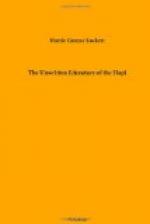The Hopi is a good dry farmer on a small scale, and farming is a laborious business in the shifting sands of Hopiland. Their corn is their literal bread of life and they usually keep one year’s crop stored. These people have known utter famine and even starvation in the long ago, and their traditions have made them wise. The man tends the fields and flocks, makes mocassins, does the weaving of the community (mostly ceremonial garments) and usually brings in the wood for fuel, since it is far to seek in this land of scant vegetation, in fact literally miles away and getting farther every year, so that the man with team and wagon is fortunate indeed and the rest must pack their wood on burros. Both men and women gather backloads of faggots wherever such can be found in walking distance, and said distance is no mean measure, for these hardy little people have always been great walkers and great runners.
Hough says:[11] “Seemingly the men work harder making paraphernalia and costumes for the ceremonies than at anything else, but it should be remembered that in ancient days everything depended, in Hopi belief, on propitiating the deities. Still if we would pick the threads of religion from the warp and woof of Hopi life there apparently would not be much left. It must be recorded in the interests of truth, that Hopi men will work at days labor and give satisfaction except when a ceremony is about to take place at the pueblo, and duty to their religion interferes with steady employment much as fiestas do in the easy-going countries to the southward. Really the Hopi deserve great credit for their industry, frugality, and provident habits, and one must commend them because they do not shun work and because in fairness both men and women share in the labor for the common good.”
[Footnote 11: Hough, Walter, Op. cit, pp. 156-58.]
IV. POTTERY AND BASKET MAKING TRADITIONAL; ITS SYMBOLISM
* * * * *
The art of pottery-making is a traditional one; mothers teach their daughters, even as their mothers taught them. There are no recipes for exact proportions and mixtures, no thermometer for controlling temperatures, no stencil or pattern set down upon paper for laying out the designs. The perfection of the finished work depends upon the potter’s sense of rightness and the skill developed by practicing the methods of her ancestors with such variation as her own originality and ingenuity may suggest.
All the women of a pueblo community know how to make cooking vessels, at least, and in spare time they gather and prepare their raw materials, just as the Navajo woman has usually a blanket underway or the Apache a basket started. The same is true of Hopi basketry; its methods, designs, and symbolism are all a matter of memory and tradition.




